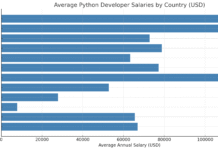Key Takeaways
• Thailand’s 2025 salary trends reveal strong wage growth in technology, finance, and healthcare sectors driven by talent shortages.
• Employers must align pay strategies with regional cost variations and the new minimum wage range of THB 337–400.
• Non-monetary benefits, flexible work models, and healthcare packages are becoming vital for attracting and retaining skilled professionals.
The salary landscape in Thailand is undergoing a significant transformation in 2025, shaped by economic recovery, evolving labor laws, technological disruption, and changing workforce expectations. As Thailand continues its journey toward becoming a high-value, innovation-driven economy, understanding current and projected salary trends has become critical for employers, job seekers, and policymakers alike.

The Thai labor market in 2025 reflects the country’s ongoing transition toward industries such as electric vehicles (EVs), digital services, renewable energy, and advanced manufacturing. These emerging sectors are driving competition for specialized talent and influencing both wage structures and employment benefits across multiple industries. According to leading economic reports and salary guides, Thailand is experiencing wage growth across both professional and blue-collar segments, with particular emphasis on technology, finance, and healthcare sectors, where skill shortages are most acute.
In response to rising inflation, shifting consumer prices, and increased foreign investment, the Thai government has also revised its minimum wage policies. The new daily wage now ranges between THB 337 and THB 400, depending on the province, marking a strategic effort to reduce income disparity and enhance living standards nationwide. This adjustment has far-reaching implications for employers managing labor costs, particularly those operating in labor-intensive industries such as agriculture, construction, and tourism.
Moreover, as regional competition intensifies, Thailand’s compensation structures are becoming more sophisticated. Employers are increasingly integrating non-monetary benefits such as hybrid work flexibility, wellness initiatives, and dependent healthcare coverage to attract and retain skilled professionals. These enhancements reflect a broader shift from purely salary-driven recruitment to holistic employee value propositions (EVPs) that prioritize work-life balance, career development, and inclusivity.
At the same time, foreign businesses expanding into Thailand must navigate a complex regulatory environment governed by the Ministry of Labour and regional wage committees. Understanding these regulations is essential for ensuring compliance with labor laws, avoiding penalties, and maintaining competitiveness in recruitment.
This comprehensive guide to salaries in Thailand for 2025 provides a detailed overview of wage structures, economic drivers, sector-specific salary ranges, and evolving HR strategies. It also explores the implications of new labor policies, cost-of-living adjustments, and market trends influencing compensation strategies across industries. Whether you are an employer designing a workforce budget, a professional seeking fair compensation, or an investor evaluating Thailand’s economic climate, this guide delivers the insights necessary to make informed, data-driven decisions in the Thai employment landscape of 2025.
Before we venture further into this article, we would like to share who we are and what we do.
About 9cv9
9cv9 is a business tech startup based in Singapore and Asia, with a strong presence all over the world.
With over nine years of startup and business experience, and being highly involved in connecting with thousands of companies and startups, the 9cv9 team has listed some important learning points in this overview of Salaries in Thailand for 2025: A Complete Guide.
If your company needs recruitment and headhunting services to hire top-quality employees, you can use 9cv9 headhunting and recruitment services to hire top talents and candidates. Find out more here, or send over an email to [email protected].
Or just post 1 free job posting here at 9cv9 Hiring Portal in under 10 minutes.
Salaries in Thailand for 2025: A Complete Guide
- The Macroeconomic Foundation: Context for 2025 Salary Planning
- Statutory Compensation: The 2025 Minimum Wage Regulatory Framework
- National Salary Averages and Income Disparity Analysis
- Detailed Salary Benchmarks by Industry and Experience Level (2025)
- Deep Dive: Salaries for Critical Professional Roles (2025)
- Total Rewards and Non-Monetary Compensation Trends
- Strategic Recommendations
1. The Macroeconomic Foundation: Context for 2025 Salary Planning
a. Economic Outlook: GDP, Inflation, and Real Wage Growth Projections
Understanding Thailand’s salary landscape for 2025 requires a comprehensive examination of its macroeconomic backdrop, labor market regulations, and evolving business competitiveness. The year 2025 represents a transitional period marked by measured economic recovery, controlled inflation, and shifting workforce dynamics, all of which play pivotal roles in shaping compensation structures and recruitment strategies across industries.
Economic Foundation and Market Context
Thailand’s economy in 2025 is characterized by moderate but stable growth, supported by an improvement in domestic consumption, targeted fiscal stimulus, and a revival in the tourism industry. The Bank of Thailand, the World Bank, and the ASEAN+3 Macroeconomic Research Office forecast GDP expansion between 2.2% and 2.9%. This steady pace of growth signals cautious optimism among employers as they balance compensation planning with productivity goals and regulatory obligations.
Key Economic Drivers
• Fiscal and Monetary Stimulus: Continued fiscal interventions, such as the Digital Wallet program, are expected to stimulate domestic purchasing power and labor market activity, especially in consumer-driven sectors.
• Tourism Revival: The tourism sector, a cornerstone of Thailand’s economy, is anticipated to reach pre-pandemic levels by mid-2025, with an estimated 40 million tourist arrivals. This resurgence will generate employment opportunities in hospitality, logistics, and retail.
• Domestic Consumption: Improved consumer confidence and moderate wage adjustments are expected to enhance spending capacity, reinforcing Thailand’s service-oriented economic model.
Inflation and Wage Dynamics
Thailand’s 2025 inflation rate remains exceptionally subdued, with projections ranging from 0.0% to 0.9%. The low inflationary environment presents favorable conditions for real wage growth, even with conservative nominal wage increases. Employers offering salary increments beyond inflation thresholds will likely boost employee purchasing power, fostering higher retention rates and consumer spending.
The following table outlines the comparative macroeconomic forecasts for Thailand in 2025:
Economic Forecasts for Thailand (2025)
| Economic Indicator | 2024 (Estimate) | 2025 Forecast | Source |
|---|---|---|---|
| GDP Growth (%) | 2.5 | 2.2 – 2.9 | Bank of Thailand, World Bank, AMRO |
| Headline Inflation (%) | 0.4 | 0.0 – 0.9 | Bank of Thailand, World Bank |
Implications for Salary Planning
• Real Wage Adjustments: Employers are expected to implement moderate pay increases aligned with economic stability, with average adjustments projected near 2.9%. This ensures sustainable growth while preserving profitability.
• Sectoral Variations: Labor-intensive sectors such as hospitality, retail, and manufacturing are likely to experience stronger wage growth due to tourism recovery and export demand.
• Talent Retention Strategy: Organizations that strategically integrate inflation-aware wage adjustments and non-monetary incentives will gain a competitive edge in retaining skilled professionals.
Strategic Alignment with Talent Acquisition
The evolving salary landscape requires businesses to balance regulatory compliance with effective talent acquisition strategies. In 2025, organizations in Thailand are expected to emphasize the following:
• Compliance with Minimum Wage Revisions: Adhering to the government’s new wage structure ensures both legal conformity and social responsibility.
• Market Benchmarking: Companies must benchmark salary packages against national and regional standards to remain attractive to top-tier talent.
• Total Rewards Framework: Beyond salary increments, employers are adopting holistic compensation strategies that include performance-based bonuses, hybrid work benefits, and skill development programs.
In summary, Thailand’s salary outlook for 2025 reflects a calculated equilibrium between economic prudence and workforce competitiveness. As organizations navigate low inflation and moderate growth, success will depend on their ability to integrate macroeconomic insights, legal compliance, and forward-thinking talent management into a cohesive compensation strategy.
b. Labor Market Dynamics: Productivity, Skill Demand, and Employment Models
The labor market in Thailand is undergoing a fundamental transformation driven by structural challenges, evolving skill requirements, and new employment models. Understanding these dynamics is crucial for employers designing competitive salary structures and sustainable workforce strategies in 2025.
Labor Market Overview and Productivity Trends
Thailand’s labor productivity has faced a persistent slowdown since the pandemic, with an average annual decline of -1.6% between 2020 and 2023. This decline, most visible in manufacturing and natural resource extraction sectors, underscores the nation’s long-term struggle to sustain wage growth without triggering inflationary pressure. The productivity gap highlights the need for comprehensive workforce reskilling and investment in innovation-led sectors to enhance long-term competitiveness.
The following table presents Thailand’s labor productivity trend over recent years:
| Year | Average Productivity Growth (%) | Key Influencing Sector |
|---|---|---|
| 2020 | -1.4 | Manufacturing and Mining |
| 2021 | -1.6 | Energy and Industrial Production |
| 2022 | -1.5 | Export-Oriented Manufacturing |
| 2023 | -1.8 | Resource Extraction and Logistics |
This consistent contraction has led policymakers and businesses to prioritize productivity reforms that align with high-value investment sectors.
Emergence of High-Value Investment and Skill Transformation
Thailand’s economic transition toward advanced manufacturing and digital technologies is reshaping the demand for labor. The government’s emphasis on developing high-value industries—such as Electric Vehicles (EVs), advanced electronics, semiconductors, and data infrastructure—has accelerated a surge in specialized talent demand.
Key Skill Areas Experiencing Rapid Demand Growth:
• Artificial Intelligence (AI) and Machine Learning Engineering
• Robotics and Automation Integration
• Data Analytics and Cloud Infrastructure Management
• Renewable Energy Systems and Smart Grid Development
• Advanced Manufacturing and Industrial Design
The AI-driven transformation is particularly influential in redefining workforce competencies. Professionals with AI-related proficiencies are now considered indispensable assets in technology-driven enterprises, making salary competitiveness in these roles a central element of talent acquisition strategy.
Flexible Employment Models and Organizational Agility
As the labor market recovers from restructuring phases observed in 2024, organizations are adopting diversified employment models to navigate uncertainty while optimizing workforce efficiency. Traditional full-time roles in functions such as accounting, HR, marketing, and manufacturing have been partially replaced by flexible or hybrid work arrangements.
Employment Composition Shifts in Thailand (2024–2025):
| Employment Type | 2024 (%) | 2025 (%) | Change (%) | Trend Interpretation |
|---|---|---|---|---|
| Full-Time Permanent | 61 | 53 | -8 | Moderate reduction due to restructuring |
| Part-Time Permanent | 20 | 42 | +22 | Significant growth in flexible contracts |
| Contract/Part-Time | 19 | 28 | +9 | Rising reliance on contingent workforce |
This transition indicates a structural recalibration of labor management strategies. Approximately 53% of organizations in Thailand plan to expand full-time hiring in early 2025, signaling renewed business confidence. However, the concurrent rise in part-time and contractual positions reflects a cautious approach toward managing operational risks amid fluctuating global economic conditions.
Strategic Implications for Employers
• Workforce Diversification: Companies are increasingly leveraging hybrid employment models to balance talent retention with cost flexibility.
• Productivity Enhancement: Investment in automation, training, and digital transformation initiatives remains essential for reversing long-term productivity decline.
• Salary Structuring: Employers must design compensation packages that reward specialized expertise, particularly in AI and technology sectors, while aligning with flexible workforce demands.
• Talent Acquisition Resilience: Organizations that successfully integrate agility and specialization into their hiring frameworks will be best positioned to attract and retain high-value professionals in 2025.
In essence, Thailand’s 2025 labor market is transitioning toward a more adaptive, skill-oriented, and technology-driven model. Employers capable of aligning their salary strategies with these labor dynamics—while adhering to evolving compliance frameworks—will hold a decisive advantage in securing sustainable workforce growth and competitive positioning in the post-pandemic economy.
c. Cost of Living Analysis: Benchmarking Purchasing Power
Understanding Thailand’s salary framework in 2025 requires a comprehensive evaluation of cost-of-living disparities across key urban and regional centers. The cost of living remains a fundamental determinant in designing equitable salary structures, ensuring fair purchasing power, and achieving compliance with evolving labor standards. Employers who tailor their compensation strategies according to geographical variations in living expenses are better positioned to attract, retain, and motivate top talent while sustaining organizational competitiveness.
Regional Cost of Living Overview
The cost of living in Thailand displays considerable regional variation, primarily influenced by factors such as rental rates, transportation expenses, and local consumer pricing. As of April 2025, the national average Cost of Living (COL) Index stands at approximately 34.1, highlighting substantial differences among Thailand’s key economic zones.
Bangkok, as the capital and primary business hub, remains the most expensive city, with a COL Index of 39.5 and a Rent Index of 14.8. Its high living costs are driven by rising property prices, transportation expenses, and service-sector consumption patterns. Phuket follows closely, featuring a slightly lower COL Index (37.1) but a higher Rent Index (17.5), reflecting its status as a premier tourism and expatriate destination. In contrast, Chiang Mai represents Thailand’s most affordable major urban area, with a COL Index of 29.9 and a Rent Index of 8.1, appealing particularly to digital nomads and retirees.
Cost of Living Indices for Major Thai Cities (April 2025)
| City | COL Index | Rent Index | Economic Characteristic |
|---|---|---|---|
| Bangkok | 39.5 | 14.8 | Financial and Commercial Capital |
| Phuket | 37.1 | 17.5 | Tourism and Expatriate Hub |
| Pattaya | 32.9 | 10.7 | Leisure and Hospitality Center |
| Chiang Mai | 29.9 | 8.1 | Low-Cost Urban Innovation Hub |
Purchasing Power and Household Expenditure Benchmark
The sustainability of wage structures depends heavily on maintaining alignment between earnings and household expenditure patterns. According to the latest national economic data, the average monthly household spending in 2023 was approximately ฿23,695. Adjusting for the moderate inflationary trends projected for 2024 (0.4%) and 2025 (0.8%), the estimated baseline for household financial sustainability reaches around ฿23,980 per month.
Household Expenditure and Inflation Adjustment (2023–2025)
| Year | Average Monthly Expenditure (THB) | Inflation Rate (%) | Adjusted Monthly Requirement (THB) |
|---|---|---|---|
| 2023 | 23,695 | – | 23,695 |
| 2024 | 23,695 | 0.4 | 23,790 |
| 2025 | 23,790 | 0.8 | 23,980 |
This calculation demonstrates that the minimum monthly income required to sustain an average household, particularly in high-cost regions such as Bangkok, Phuket, and Ko Samui, must align closely with these inflation-adjusted expenditure levels.
Impact on Salary Planning and Wage Adjustments
• Regional Wage Differentiation: Employers operating in high-cost cities must implement region-specific wage structures to maintain employee purchasing power and prevent wage stagnation.
• Minimum Wage Recalibration: The rise of Thailand’s minimum wage to THB 400 per day in premium cost-of-living regions is not merely a regulatory requirement but a socioeconomic necessity to preserve household sustainability.
• Workforce Mobility Considerations: As urban costs rise, companies may explore remote and hybrid work models, redistributing employment opportunities to lower-cost cities such as Chiang Mai and Khon Kaen.
• Inflation-Indexed Compensation Models: Organizations integrating inflation-linked salary adjustments ensure long-term workforce retention and improved morale amid evolving cost pressures.
Strategic Implications for Employers
Employers who integrate cost-of-living benchmarks into their salary planning gain a significant advantage in both compliance and recruitment. Competitive compensation packages that reflect the real cost of urban living enhance employer branding and attract skilled professionals from both local and international markets.
Moreover, aligning salary structures with regional economic realities contributes to broader economic stability. It ensures that minimum statutory earnings, particularly in high-cost zones, align with basic consumption requirements—thereby promoting social equity, household resilience, and national productivity growth.
In conclusion, salary planning in Thailand for 2025 demands a holistic approach that integrates cost-of-living data, inflation trends, and wage regulations. By tailoring compensation strategies to match regional purchasing power, businesses can strengthen their recruitment strategies, ensure fair compensation, and sustain compliance with Thailand’s evolving labor market dynamics.
2. Statutory Compensation: The 2025 Minimum Wage Regulatory Framework
a. The Multi-Tiered Minimum Wage Structure (Effective July 1, 2025)
Thailand’s compensation framework in 2025 reflects the country’s evolving economic landscape and the government’s attempt to balance wage growth, regional development, and business competitiveness. The new statutory wage regulations reinforce the need for employers to align their salary structures with compliance mandates while maintaining an equitable and attractive compensation framework for talent acquisition.
Overview of Thailand’s Multi-Tiered Minimum Wage System
Thailand continues to maintain a differentiated, multi-tiered minimum wage system designed to reflect regional disparities in cost of living and industrial development. This structure, while promoting flexibility, requires rigorous compliance oversight from businesses operating in multiple provinces or across diverse industry sectors. The varying wage tiers aim to ensure economic sustainability, prevent wage distortions, and accommodate both urban and rural market dynamics.
As of 2025, the government’s primary objective is to establish greater parity between high-cost and low-cost regions while stimulating domestic consumption. The latest wage adjustments represent one of the most comprehensive reforms in Thailand’s modern labor history, ensuring that compensation levels are both socially sustainable and economically strategic.
Thailand Minimum Wage Framework (Effective July 1, 2025)
| Wage Category | Minimum Daily Wage (THB) | Geographic / Sectoral Application | Average Change (%) | Regulatory Source |
|---|---|---|---|---|
| Tier 1 | 337 | Lower-cost provinces and developing regions | +2.9 | National Wage Committee Notification (No.14) |
| Tier 2 | 370–390 | Mid-range provinces and semi-urban areas | +2.9 | National Wage Committee Notification (No.14) |
| Tier 3 | 400 | Urban hubs and designated industrial zones | +2.9 | National Wage Committee Notification (No.14) |
Expansion of the THB 400 Wage Tier
The most significant policy shift came with the publication of the National Wage Committee Notification (No. 14) in the Royal Gazette on July 1, 2025. This amendment expanded the highest minimum wage tier (THB 400) to cover both geographic and industry-specific categories, thereby enhancing wage equity across regions with higher operational costs and labor intensity.
Geographic Expansion of the THB 400 Wage
The THB 400 rate now applies comprehensively to all businesses operating in:
• Bangkok – the country’s principal metropolitan hub with the highest cost of living.
• Chachoengsao, Chonburi, Rayong – industrial provinces forming Thailand’s Eastern Economic Corridor (EEC).
• Phuket – a high-tourism province with elevated rental and service costs.
• Ko Samui (Surat Thani) – a key tourism and hospitality hub with strong international employment demand.
Sectoral Expansion Across Provinces
In addition to regional adjustments, the THB 400 minimum wage rate now applies nationwide to specific business sectors identified as high-value and labor-intensive. These include:
• Hospitality Industry: Hotels categorized as types 2, 3, and 4 under the Hotel Act.
• Entertainment Industry: Establishments falling under the Entertainment Places Act, encompassing entertainment venues, nightclubs, and tourism-linked facilities.
These targeted adjustments are designed to ensure wage consistency and improve working conditions in Thailand’s most visible service sectors, particularly those catering to international tourism and foreign investment.
Strategic and Economic Implications
• Compliance Reinforcement: Businesses operating across provinces must adopt robust payroll compliance systems to align with the differentiated wage framework.
• Workforce Retention and Equity: The extended THB 400 rate reduces wage inequality and strengthens labor retention, particularly in high-cost and tourism-driven regions.
• Competitiveness in Talent Markets: Employers offering compliance-aligned wages can enhance brand reputation and appeal to both domestic and international job seekers.
• Sectoral Wage Benchmarking: The hospitality and entertainment industries now serve as benchmark sectors for wage competitiveness in Thailand’s broader service economy.
Analytical Summary: Wage Impact Assessment (2025)
| Sector / Region | Minimum Daily Wage (THB) | Projected Monthly Income (THB)* | Labor Market Sensitivity | Talent Attraction Rating |
|---|---|---|---|---|
| Bangkok & EEC Provinces | 400 | 10,400 – 12,000 | High | Strong |
| Tourism & Hospitality (Nationwide) | 400 | 10,400 – 12,000 | Very High | Strong |
| Manufacturing (Provincial) | 337 – 370 | 8,762 – 9,620 | Moderate | Average |
(*Based on 26–30 working days per month)
In conclusion, Thailand’s 2025 minimum wage policy represents a strategic evolution in national labor governance. It reinforces social protection through standardized minimum earnings while encouraging fair competition and workforce mobility. For employers, this reform signals a new era of compensation design—where compliance, equity, and market competitiveness must coexist to drive sustainable growth and talent acquisition success.
b. Detailed Analysis of Provincial and District Minimum Daily Wage Rates
Thailand’s 2025 minimum wage landscape reveals a highly segmented regulatory framework, emphasizing the country’s diverse economic geography and varying cost-of-living conditions. The differentiated provincial and district-based wage rates compel businesses—particularly multinational corporations—to adopt location-specific payroll systems that comply with distinct legal and economic parameters. The statutory wage disparity, ranging between THB 337 and THB 400, underscores the country’s policy approach to balancing regional competitiveness with equitable labor protection.
Understanding Thailand’s Provincial Wage Fragmentation
The multi-tiered wage framework reflects Thailand’s economic stratification across urban, industrial, and rural regions. Provinces with robust industrial activity, high tourism demand, and elevated living expenses, such as Bangkok, Chonburi, and Phuket, have been categorized under the highest wage tiers. Conversely, provinces with slower economic development or lower urban density continue to operate under the lower-tier wage brackets.
This wage stratification system ensures proportionality between wage levels, regional productivity, and local purchasing power, allowing employers to maintain competitiveness while adhering to fair wage standards.
Comprehensive Overview of Minimum Daily Wage Rates (Effective July 1, 2025)
| Minimum Daily Wage (THB) | Scope of Application | Key Provinces / Districts | Economic Classification |
|---|---|---|---|
| 400 | Highest Tier (Urban / Coastal) | Bangkok, Chachoengsao, Chonburi, Rayong, Phuket, Ko Samui (Surat Thani) | Major industrial and tourism hubs with high cost of living |
| 400 | Sector-Specific Nationwide Rate | Hotel Businesses (Types 2–4), Entertainment Venues (as per legal acts) | Nationwide application for tourism and entertainment industries |
| 380 | High-Tier District Rate | Mueang Chiang Mai (Chiang Mai), Hat Yai (Songkhla) | High tourism and service economy zones |
| 372 | Upper-Mid Tier | Nakhon Pathom, Nonthaburi, Pathum Thani, Samut Prakan, Samut Sakhon | Industrial belt and extended Bangkok metropolitan region |
| 359 | Mid-Tier | Nakhon Ratchasima, Samut Songkhram | Growing manufacturing and logistics hubs |
| 357 | Mid-Tier | Khon Kaen, Chiang Mai (excluding Mueang), Prachinburi, Ayutthaya, Saraburi | Secondary industrial and trade centers |
| 356 | Lower Mid-Tier | Lopburi | Transitional provincial economy |
| 337–355 | Lowest Tier | Remaining provinces including Nakhon Nayok, Suphanburi, Nong Khai | Rural or agricultural provinces with lower living costs |
Regional Wage Stratification Matrix
| Wage Tier | Economic Zone Type | Average COL Index (2025) | Representative Provinces | Key Industry Clusters |
|---|---|---|---|---|
| High (THB 400) | Urban/Coastal | 37.5–39.5 | Bangkok, Phuket, Rayong | Tourism, Manufacturing, Finance |
| Upper-Mid (THB 372–380) | Semi-Urban Industrial | 33.0–35.0 | Chiang Mai, Samut Sakhon | Manufacturing, Logistics |
| Mid (THB 357–359) | Regional Growth | 31.0–32.5 | Ayutthaya, Khon Kaen | Automotive, Industrial Trade |
| Low (THB 337–355) | Agricultural / Rural | 28.0–30.0 | Suphanburi, Nong Khai | Agriculture, Food Processing |
Strategic Implications for Employers
• Payroll Compliance Complexity: Businesses must adapt payroll and HR systems to accommodate geographically specific wage requirements, ensuring adherence to provincial regulations and avoiding penalties.
• Regional Salary Benchmarking: Employers should integrate provincial wage data into compensation benchmarking to maintain equity across multi-location operations.
• Talent Acquisition Strategy: Competitive salaries in high-tier regions can serve as strong retention and attraction tools for skilled professionals, particularly in sectors like tourism, manufacturing, and digital technology.
• Cost Control and Workforce Distribution: Organizations may consider redistributing non-core functions to lower-wage provinces to optimize labor costs without compromising compliance or quality.
Economic and Workforce Impact Assessment
| Parameter | High-Tier Provinces | Mid-Tier Provinces | Low-Tier Provinces |
|---|---|---|---|
| Average Daily Wage (THB) | 400 | 359–380 | 337–355 |
| Cost of Living Index (2025) | High | Moderate | Low |
| Talent Availability | Skilled and Competitive | Semi-skilled | Entry-level and Agricultural |
| Employment Cost Pressure | High | Medium | Low |
In summary, Thailand’s provincial wage framework for 2025 represents a deliberate policy balancing act—aimed at enhancing labor welfare, promoting wage fairness, and preserving regional competitiveness. For employers, effective salary planning requires an integrated approach that aligns compensation policies with both economic realities and regulatory requirements. By strategically mapping wage tiers against productivity, living standards, and talent availability, organizations can ensure sustainable growth, compliance integrity, and long-term workforce stability.
c. Impact Assessment on Labor Costs
Thailand’s 2025 minimum wage revision represents one of the country’s most transformative labor reforms in recent years, directly influencing both workforce welfare and corporate cost structures. This wage recalibration has far-reaching implications across labor markets, business operations, and national economic policy—aiming to promote social inclusivity while simultaneously challenging the operational sustainability of small and medium-sized enterprises.
Economic and Social Impact
• Worker Welfare and Income Distribution:
The government estimates that nearly 700,000 employees will experience direct wage improvements under the revised minimum wage framework. This shift is expected to stimulate household purchasing power, reduce income disparities, and inject additional liquidity into local economies. The policy aligns with Thailand’s strategic vision to enhance equitable economic growth by bridging the income gap between urban and rural workforces.
• Labor Market Rebalancing in Post-Pandemic Recovery Sectors:
Key industries such as hospitality, tourism, and food services—severely affected during the pandemic—stand to benefit substantially from the reform. The standardized wage increase enhances the attractiveness of these sectors to workers who previously migrated to higher-paying industries, strengthening staff retention and improving service quality.
Industrial Cost Pressure Analysis
While the reform aims to foster inclusivity, it simultaneously escalates labor costs, particularly within labor-intensive and cost-sensitive sectors.
• SMEs and Production Overheads:
Small and medium enterprises face the most acute cost escalation, given their dependency on low-wage labor. Industries such as agriculture, construction, and hospitality previously sustained significant proportions of their workforce below the THB 355/day threshold in 2023. The enforced wage elevation has triggered an operational recalibration, compelling SMEs to reassess budgets, pricing models, and productivity metrics.
• Sector-Specific Implications:
The hotel industry faces a particularly pronounced adjustment. The nationwide application of the THB 400 minimum wage—regardless of provincial cost disparities—has standardized labor expenses across regions. While large hotel chains benefit from predictable cost structures and competitive wage parity, independent operators in lower-wage provinces face steep payroll expansions ranging from 10% to 19%.
Comparative Analysis of Cost Escalation by Sector
| Sector | % of Workers Below THB 355/day (2023) | Estimated Cost Increase (Post-2025 Wage Hike) | Key Impacted Business Types |
|---|---|---|---|
| Agriculture | 77% | 12% – 15% | Smallholder Farms, Agri-Coops |
| Construction | 30% | 8% – 12% | Local Contractors, Infrastructure SMEs |
| Hotels & Restaurants | 23% | 10% – 19% | Independent Hotels, Local Eateries |
Strategic Business Adjustments
• Workforce Optimization and Automation:
Enterprises are increasingly exploring labor-saving technologies, digital workforce management, and process automation to mitigate cost escalation.
• Compensation Structure Review:
Organizations are restructuring payroll frameworks, introducing tiered benefits, and incorporating variable performance incentives to balance wage competitiveness with profitability.
• Regional Talent Strategy Alignment:
Corporations with nationwide operations are realigning recruitment strategies to leverage regional strengths, optimize cost-efficiency, and ensure regulatory compliance with provincial labor directives.
Overall, Thailand’s 2025 minimum wage policy embodies a dual-edged transformation—reinforcing social welfare and consumer confidence on one hand while imposing significant fiscal realignments across industries on the other. Its long-term success will hinge on how effectively businesses recalibrate their compensation models, productivity measures, and workforce strategies in response to this regulatory shift.
3. National Salary Averages and Income Disparity Analysis
a. Reconciling Official Averages vs. Professional Market Benchmarks
Understanding Thailand’s salary structure in 2025 requires a nuanced analysis that distinguishes between official statistical data and the actual earnings landscape within the professional labor market. The gap between government-reported averages and real-world remuneration levels illustrates the persistent income inequality that defines much of the Thai economy. For organizations pursuing effective compensation strategies, acknowledging this disparity is essential for maintaining competitiveness and compliance.
Reconciling Official Data with Professional Market Benchmarks
• Limitations of Official Salary Data:
According to the Bank of Thailand’s data from November 2024, the nation’s official average monthly salary stood at approximately THB 15,900. While accurate in macroeconomic terms, this figure is heavily influenced by the significant number of workers employed in the agricultural, informal, and low-wage service sectors. As a result, it presents a distorted reflection of the earnings landscape for skilled and professional workers.
• Professional Market Compensation Reality:
In contrast, professional salary surveys reveal that the average monthly base salary across skilled professions in Thailand is around THB 46,117, translating to an annual income of approximately THB 553,409. Moreover, the average net monthly income in Bangkok—after taxes and statutory deductions—stands at roughly THB 19,753.88. This reduction highlights the impact of income taxation and social contributions on disposable income, particularly in urban areas where living costs remain substantially higher.
Comparative Salary Indicators: Official vs. Professional Market
| Salary Type | Monthly Average (THB) | Annualized Value (THB) | Data Source | Coverage Scope |
|---|---|---|---|---|
| Official National Average | 15,900 | 190,800 | Bank of Thailand (Nov 2024) | All Labor Sectors (Including Informal) |
| Professional Market Average | 46,117 | 553,409 | Market Salary Surveys | Skilled and Professional Workers |
| Bangkok Net Average (Post-Tax) | 19,753.88 | 237,046.56 | Urban Workforce Data | High-Cost Metropolitan Areas |
Implications for Talent Acquisition and Compensation Strategy
• Misalignment Between Policy and Market Reality:
Thailand’s pronounced income disparity, among the most significant in Southeast Asia, renders the official national average an unreliable benchmark for strategic compensation planning. Employers that design pay structures based on the THB 15,900 baseline risk being unable to attract or retain qualified talent, particularly in specialized fields requiring advanced education or technical expertise.
• Sector-Specific Benchmarking as a Strategic Imperative:
Multinational companies and domestic corporations must instead align salary planning with sector-specific data. Industries such as technology, engineering, and finance report mid-career salary ranges typically between THB 50,000 and THB 100,000 per month, with senior professionals commanding even higher packages.
• Geographic and Cost-of-Living Considerations:
Regional salary differentiation is also critical. Bangkok, Chonburi, and Rayong generally exhibit higher pay scales compared to northern and northeastern provinces, reflecting the concentration of multinational operations, industrial clusters, and urbanized workforce demands.
Income Inequality Index: Regional Disparity Overview (2025)
| Region | Average Monthly Salary (THB) | Estimated Cost of Living Index | Income-to-Cost Ratio | Economic Classification |
|---|---|---|---|---|
| Bangkok Metropolitan Area | 46,000 | 100 | 0.46 | High-Income Urban Zone |
| Eastern Economic Corridor | 38,500 | 88 | 0.44 | Industrial Growth Region |
| Northern Region | 28,000 | 70 | 0.40 | Developing Region |
| Northeastern Region | 25,500 | 65 | 0.39 | Agrarian and Emerging Market |
Strategic Takeaways
• Compensation decisions in Thailand must be grounded in real-market data, not aggregated national averages.
• Sectoral, geographical, and career-stage benchmarks provide a more accurate foundation for budgeting and recruitment strategies.
• Addressing wage inequality through structured, merit-based pay systems and transparent salary scales enhances organizational reputation and supports long-term talent retention.
In summary, Thailand’s 2025 salary landscape underscores the critical importance of precision in compensation planning. A data-driven approach—combining official statistics with professional benchmarking and regional analysis—enables employers to strike the right balance between compliance, competitiveness, and equitable talent acquisition.
4. Detailed Salary Benchmarks by Industry and Experience Level (2025)
Understanding salary benchmarks by sector and experience level is fundamental for organizations seeking to establish competitive remuneration frameworks in Thailand’s 2025 employment landscape. Market dynamics, regulatory changes, and digital transformation have collectively created an increasingly segmented salary structure that reflects sectoral demand, skill specialization, and economic recovery patterns. These benchmarks serve as essential tools for employers developing entry- and mid-level hiring strategies, as well as for professionals evaluating career progression opportunities.
Overview of Salary Ranges Across Major Sectors
The base salary ranges for roles spanning zero to seven years of experience in 2025 reveal pronounced differences driven by sector competitiveness, digitalization, and demand for skilled professionals. Industries such as Information Technology, Healthcare, and Finance continue to offer higher compensation packages relative to traditional sectors like Hospitality, Retail, and Construction.
Estimated Monthly and Annual Base Salary Ranges by Industry (0–7 Years Experience, 2025)
| Job Sector | Monthly Salary Range (THB) | Annual Salary Range (THB) | Key Trend or Growth Insight |
|---|---|---|---|
| IT and Technology | 25,000 – 120,000 | 300,000 – 1,440,000 | Highest growth forecast (8–12%) driven by AI, automation, and data analytics |
| Healthcare and Social Services | 30,000 – 200,000 | 360,000 – 2,400,000 | Wide range reflecting specialized medical and health expertise |
| Accounting and Finance | 22,000 – 200,000 | 264,000 – 2,400,000 | Strong demand for compliance, audit, and digital finance professionals |
| Marketing | 20,000 – 150,000 | 240,000 – 1,800,000 | Rapid expansion in digital marketing and brand analytics roles |
| Engineering | 15,000 – 150,000 | 180,000 – 1,800,000 | Boosted by investments in EV, infrastructure, and construction industries |
| Shipping, Manufacturing, and Transportation | 20,000 – 150,000 | 240,000 – 1,800,000 | Growth tied to logistics innovation and supply chain optimization |
| Construction | 20,000 – 80,000 | 240,000 – 960,000 | Driven by renewed public and private infrastructure investments |
| Hospitality and Tourism | 10,000 – 70,000 | 120,000 – 840,000 | Impacted by the nationwide THB 400 minimum wage adjustment |
| Retail and Consumer Products | 13,000 – 100,000 | 156,000 – 1,200,000 | Stable growth driven by consumer recovery and e-commerce expansion |
Sector-Specific Insights and Strategic Implications
Technology and Digital Transformation: The New Talent Battlefield
• The technology sector leads all industries with a projected salary increase of 8–12% in 2025. This rise underscores Thailand’s growing dependence on AI-driven systems, big data analytics, and cybersecurity.
• The competition for high-skilled digital professionals has intensified, especially in areas like software development, machine learning, and data science.
• Organizations capable of integrating non-monetary benefits—such as hybrid work models, remote employment flexibility, and continuous upskilling programs—have successfully positioned themselves as employers of choice.
• This trend reflects a fundamental shift from salary-based competition to total value proposition strategies, where lifestyle flexibility and learning opportunities hold equivalent weight to compensation.
Hospitality and Tourism: Navigating the Minimum Wage Mandate
• The Hospitality and Tourism sector, a cornerstone of Thailand’s economic resurgence, is directly impacted by the national implementation of the THB 400 daily minimum wage for hotel-related businesses.
• This adjustment effectively raises the lower end of the salary spectrum, standardizing entry-level compensation to approximately THB 10,400 per month (based on 26 working days).
• The measure aims to ensure wage equity and improve workforce retention by stabilizing employment in a sector previously characterized by high turnover and wage disparities.
• However, while the mandate supports equitable pay, it also imposes financial strain on smaller tourism enterprises, particularly in regions where pre-adjustment wage levels averaged between THB 337 and THB 355 per day.
Comparative Sector Performance Matrix (2025 Forecast)
| Sector | Projected Annual Growth (%) | Talent Shortage Level | Competitive Advantage Factor | Strategic Outlook |
|---|---|---|---|---|
| Technology and IT | 8 – 12 | Very High | AI, Cloud, Data Expertise | Strong upward trajectory |
| Healthcare | 7 – 10 | High | Specialist Medical Skills | Continued expansion |
| Finance and Accounting | 6 – 9 | Moderate | Regulatory and Digital Finance Knowledge | Stable with digitalization focus |
| Marketing and Media | 5 – 8 | Moderate | Digital Campaign Expertise | Robust in e-commerce growth |
| Hospitality and Tourism | 4 – 7 | High | Customer Service and Operations | Recovering with wage reforms |
| Manufacturing and Engineering | 5 – 7 | Moderate | Technical and Project Management | Dependent on industrial investments |
Strategic Takeaways for Employers and HR Leaders
• Employers must anchor their salary structures to industry-specific benchmarks rather than national averages to ensure competitiveness and compliance.
• Investing in upskilling initiatives, digital tools, and flexible work options can significantly improve talent retention in high-demand sectors.
• Wage standardization policies, such as the THB 400 minimum wage, are reshaping Thailand’s compensation framework, narrowing income disparities while influencing cost structures for small and medium enterprises.
• A data-driven approach that combines compensation benchmarking with economic forecasts enables organizations to remain agile and aligned with regulatory expectations.
By comprehensively analyzing salary differentials and growth projections across key industries, Thailand’s 2025 salary framework reveals a nation transitioning toward a knowledge-based, digitally integrated economy. For employers, aligning compensation strategies with these realities is no longer optional—it is a decisive factor in sustaining workforce competitiveness and long-term operational success.
5. Deep Dive: Salaries for Critical Professional Roles (2025)
a. Senior Software Engineer Compensation (Technology Benchmark)
Compensation patterns for critical professional positions offer valuable insight into Thailand’s evolving salary landscape and reflect the nation’s transition toward a skill-driven, innovation-led economy. Among all sectors, the technology field—particularly software engineering—remains a key indicator of wage competitiveness and talent scarcity.
Senior Software Engineer Compensation as the Technology Benchmark
The role of the Senior Software Engineer represents one of the most strategically significant positions in Thailand’s 2025 labor market. It not only serves as a benchmark for evaluating technical compensation trends but also mirrors the broader economic emphasis on digital transformation, artificial intelligence, and software development infrastructure.
Nationally, the average annual base salary for Senior Software Engineers in 2025 stands at approximately THB 1,016,291. This figure illustrates the rising valuation of technical expertise in a rapidly digitizing economy. However, when regional dynamics are considered, Bangkok commands a notable wage premium—pushing the average annual base salary for the same position to THB 1,112,006. This disparity underscores the concentration of high-value digital enterprises, international headquarters, and foreign direct investment projects within the capital’s metropolitan area.
Experience-Based Compensation Differentiation
Earnings in this field are directly correlated with both experience and technical specialization. Professionals progress through a steep salary trajectory within their first decade of employment, with compensation plateauing at mid-senior levels due to the high base and strong variable incentive structures.
Estimated Annual Compensation by Experience Level (Senior Software Engineer, 2025)
| Experience Level | Average Total Annual Compensation (THB) | Bangkok Market Average (THB) | Variable Pay (National Average) |
|---|---|---|---|
| Early Career (1–4 years) | 1,109,189 | 1,142,000 | Up to 240,000 |
| Mid-Career (5–9 years) | 1,113,505 | 1,165,000 | Up to 337,000 |
Analysis of Variable Compensation Components
The compensation structure for Senior Software Engineers in Thailand is not confined to fixed salaries. Variable pay components—particularly bonuses, profit sharing, and performance-linked incentives—represent a growing portion of total compensation. Nationally, variable components can add between 20% and 30% to annual income.
• Profit Sharing: Common among multinational tech firms and startups, with typical national payouts reaching up to THB 337,000 per year.
• Bangkok Differential: Companies based in Bangkok offer slightly lower variable pay (averaging THB 240,000) due to higher base salaries and broader benefits packages.
• Equity Participation: In high-growth sectors such as fintech and software-as-a-service (SaaS), equity options are increasingly introduced as part of long-term retention strategies.
Geographical Wage Premium and Industry Influence
The Bangkok technology corridor continues to exert strong upward pressure on national salary averages. Its concentration of innovation hubs, regional data centers, and international R&D investments reinforces higher-than-average wage structures. Comparatively, emerging technology centers such as Chiang Mai and Chonburi offer competitive salaries but at a 10–15% discount relative to Bangkok, reflecting differences in cost of living and corporate footprint.
Regional Compensation Comparison Matrix (Senior Software Engineer, 2025)
| Location | Average Annual Salary (THB) | Percentage Difference vs. National Average | Key Contributing Factors |
|---|---|---|---|
| Bangkok | 1,112,006 | +9.4% | High concentration of MNCs, advanced tech infrastructure |
| Chiang Mai | 945,000 | -7% | Growing tech startup ecosystem |
| Chonburi | 915,000 | -10% | Industrial zone proximity, limited software hubs |
| Phuket | 890,000 | -12% | Tourism-driven economy, fewer IT headquarters |
Strategic Implications for Employers and Policymakers
• For employers: Retaining top-tier software engineering talent requires not only competitive salary offers but also holistic compensation strategies that integrate variable incentives, hybrid work flexibility, and career development pathways.
• For policymakers: The pronounced regional disparities highlight the need for digital infrastructure decentralization and incentives that encourage high-value tech employment beyond Bangkok.
• For talent acquisition specialists: Understanding salary elasticity by region and specialization is critical for workforce planning and recruitment efficiency.
Overall, the compensation landscape for Senior Software Engineers in Thailand 2025 reflects the country’s broader journey toward technological competitiveness and digital self-sufficiency. Employers who align pay structures with market realities and offer multidimensional value propositions are best positioned to secure and retain scarce technical expertise in an increasingly competitive regional labor market.
b. Marketing Manager Compensation and Data Disparity
Marketing Manager compensation in Thailand for 2025 demonstrates pronounced variability across salary surveys, reflecting the fragmented structure of the country’s professional labor market. The role’s compensation benchmarks reveal how digital transformation, strategic leadership responsibilities, and sector-specific demands significantly influence overall remuneration levels.
Market Benchmark Analysis
According to comprehensive salary data, the national average annual base salary for a Marketing Manager in 2025 is estimated at approximately ฿819,512. However, a parallel dataset reports a much higher gross annual figure of around ฿1,836,498, inclusive of a mean bonus allocation of ฿214,319. This wide discrepancy between salary data sources highlights methodological differences—one focusing on mid-level marketing professionals, while the other encompasses senior managerial and strategic leadership positions, especially those in multinational and digital-centric organizations.
Compensation Breakdown and Strategic Implications
For talent acquisition teams, understanding the underlying cause of this variance is critical. The lower benchmark (฿819,512) often corresponds to traditional marketing roles in domestic firms, while the upper tier (฿1.83 million) reflects leadership positions tied to business development, omnichannel marketing, and data-driven strategy. Organizations targeting high-impact marketing professionals or leaders responsible for digital transformation initiatives are advised to budget closer to the upper range to remain competitive within Thailand’s modern corporate ecosystem.
The following table provides an illustrative overview of compensation structures:
Table: Marketing Manager Salary Structure in Thailand, 2025
| Compensation Component | Average Range (THB) | Description |
|---|---|---|
| Base Salary (General Marketing) | 819,000 – 1,000,000 | Standard marketing roles in local enterprises |
| Base Salary (Digital/Strategic) | 1,500,000 – 1,836,498 | Senior roles involving digital leadership |
| Average Bonus | 200,000 – 250,000 | Annual performance-related bonus |
| Profit Sharing | 110,000 – 630,000 | Incentives tied to company profitability |
| Commissions (Performance Linked) | Up to 130,000 | Applied mainly to marketing roles with sales targets |
Analytical Insights for Employers
High-performing Marketing Managers, particularly in Bangkok and multinational firms, command premium salaries due to their strategic importance in market expansion, digital optimization, and brand innovation. Employers seeking to attract and retain such talent must align pay structures with industry-specific and experience-based benchmarks. Furthermore, integrating performance-driven compensation models—such as profit sharing and bonuses—remains essential for sustaining motivation and reducing attrition in a competitive job market.
In summary, the disparity in reported compensation levels underscores the need for localized, data-driven benchmarking. For 2025 and beyond, companies must prioritize adaptive compensation strategies that reflect Thailand’s evolving marketing landscape, ensuring compliance with regulatory frameworks while maximizing talent acquisition efficiency.
c. Senior Accountant/Financial Analyst Compensation
Compensation trends for Senior Accountants and Financial Analysts in Thailand for 2025 illustrate the sharp correlation between professional experience, geographical location, and earning potential. These roles, positioned at the core of financial governance and regulatory compliance, command increasing value as Thailand’s economy evolves and multinational investment continues to expand within the Bangkok metropolitan area.
Market Compensation Overview
Across Thailand, the average annual base salary for Senior Accountants is estimated at approximately ฿732,503. However, the financial epicenter of Bangkok offers a notable salary premium—senior accountants with more than eight years of experience earn around ฿963,837 per year. This represents roughly a 31% compensation increase compared to the national mean, reflecting both the higher cost of living in the capital and the concentration of regional headquarters, multinational subsidiaries, and financial institutions requiring advanced accounting expertise.
Experience-Based Compensation Progression
The following table outlines the evolution of salary levels across experience tiers for accounting professionals:
Table: Senior Accountant Salary Benchmark in Thailand, 2025
| Experience Level (Years) | Average Total Compensation (THB) | Observations |
|---|---|---|
| Early Career (1–4 years) | 400,000 – 520,000 | Entry-level roles focused on reporting and data validation |
| Mid-Career (5–9 years) | 543,797 | Involvement in auditing, budget analysis, and forecasting |
| Senior-Level (10–19 years) | 779,569 | Strategic financial management and regulatory compliance |
| Bangkok Senior-Level (8+ years) | 963,837 | Leadership positions in corporate finance or multinational firms |
Geographical and Strategic Implications
The pronounced wage differential between Bangkok and other regions highlights the capital’s dominance as Thailand’s financial nucleus. Multinational enterprises and major domestic corporations often centralize finance operations in Bangkok, driving demand for high-caliber professionals proficient in IFRS, Thai GAAP, and advanced financial analytics. This demand directly influences compensation strategies, making Bangkok-based financial roles some of the most lucrative in the nation.
Talent Acquisition Considerations
For employers seeking to attract or retain senior accounting and finance professionals, compensation packages must go beyond base salary. Incorporating performance-linked incentives, annual bonuses, and long-term benefits—such as retirement contributions or professional development funding—is essential for maintaining competitiveness. Organizations that align compensation structures with global standards, while accounting for local market dynamics, will be better positioned to secure top-tier financial talent in Thailand’s evolving 2025 labor landscape.
d. Preliminary Benchmarks for Other Roles
Preliminary compensation benchmarks for 2025 provide a broad yet insightful overview of the Thai labor market across professional roles. While some salary data originates from public sources such as the Michael Page 2025 Salary Guide, it is essential to interpret such figures carefully due to potential methodological differences and incomplete variable pay data. This section presents a contextualized and comparative understanding of salary structures across key professional roles in Thailand, with emphasis on reliability, market variance, and implications for strategic workforce planning.
Interpretation of Low-End Benchmark Figures
Early-stage data shows annual salaries for certain professional roles as follows:
- Accountant: ฿90,000 per annum
- Sales Manager: ฿100,000 per annum
- Quality Manager: ฿110,000 per annum
These figures—translating to approximately ฿7,500 to ฿9,200 per month—are significantly below Thailand’s 2025 minimum wage threshold and far lower than established industry benchmarks. The data likely reflects entry-level base pay excluding bonuses or variable commissions, potentially within micro or early-stage enterprises. It may also represent incomplete reporting or an outlier segment within informal employment categories. Consequently, these figures should not be relied upon as representative of Thailand’s professional salary averages for strategic HR or financial planning.
Table: Comparative 2025 Salary Benchmarks for Key Professional Roles
| Role | Average Annual Base Salary (THB) | Average Total Compensation (THB) | Experience Context | Source Premium Insight |
|---|---|---|---|---|
| Senior Software Engineer (Bangkok) | ~฿1,112,006 | ~฿1,112,006 + Variable Pay | Mid-Career to Senior | Location Premium – Bangkok Technology Hub |
| Senior Accountant (Bangkok, 8+ Yrs) | ~฿732,503 (National Avg) | ~฿963,837 | Senior-Level | Location and Experience Premium |
| Marketing Manager (High-End Estimate) | N/A | ~฿1,836,498 + Bonus | Strategic/Senior Management | Digital and Leadership Role Premium |
Compensation Reliability and Market Context
These salary benchmarks highlight the wide disparity across professional fields in Thailand’s 2025 economy. The software engineering and marketing sectors display the strongest earning potential due to digital transformation initiatives and the rising need for technologically skilled professionals. Conversely, finance roles, while more stable, remain geographically sensitive—Bangkok professionals typically earn up to 30% more than their provincial counterparts due to cost-of-living adjustments and corporate concentration.
Graph: Relative Salary Ranges by Sector (2025, THB ‘000)
| Sector | Average Annual Salary Range | Market Trend |
|---|---|---|
| Technology & IT | 900 – 1,400 | High Growth (8–12% YoY) |
| Finance & Accounting | 700 – 960 | Steady with Location Premium |
| Marketing & Digital | 1,200 – 1,850 | Rapid Expansion due to Digitalization |
| Manufacturing & Quality | 400 – 800 | Stable, Productivity-Driven |
Strategic Implications for Employers
Organizations seeking to strengthen their 2025 hiring strategy must contextualize salary benchmarks within both regulatory and competitive frameworks. Overreliance on low-end public data may result in underbudgeting for critical talent acquisition. Instead, employers should incorporate localized market intelligence, compensation analytics, and predictive modeling when designing salary bands. Aligning pay structures with Thailand’s wage policies, inflation forecasts, and digital skill premiums will ensure regulatory compliance and competitive positioning in a tightening labor market.
6. Total Rewards and Non-Monetary Compensation Trends
a. Annual Bonus and Incentive Structures
The 2025 compensation landscape in Thailand reveals a strategic shift among employers toward total rewards systems that extend beyond traditional salary structures. Organizations are increasingly leveraging non-monetary compensation and performance-based incentives to attract, motivate, and retain high-performing professionals in a competitive market environment characterized by rising wage expectations and intensified talent competition. This evolution aligns closely with global best practices in human capital management, reflecting a strong emphasis on work-life balance, flexibility, and outcome-based reward models.
Non-Monetary Compensation and Flexible Benefits
Employers across Thailand are prioritizing comprehensive total rewards strategies that incorporate flexible benefits alongside monetary incentives. With approximately 87% of professionals expecting a salary increase in 2025, organizations are seeking to balance expectations through non-salary enhancements such as:
- Hybrid and remote working flexibility to improve employee engagement and productivity
- Enhanced medical and wellness coverage, including mental health programs and preventive care
- Professional development support such as upskilling programs, certifications, and education sponsorships
- Work-life balance initiatives including flexible hours, additional leave days, and family support benefits
These offerings enable firms to manage wage inflation pressures effectively while still maintaining a strong employer value proposition.
Annual Bonus and Incentive Structures
Variable pay has become an indispensable component of Thailand’s compensation strategy in 2025. It serves not only as a morale-boosting mechanism but also as a performance management tool, aligning compensation directly with individual and organizational results.
Key observations include:
- 84% of surveyed organizations provided performance-based bonuses in 2025.
- The prevailing market standard equates to a two-month annual bonus—approximately 16.7% of the base salary.
- This far exceeds global averages, which typically range between 2% and 7%.
Such bonus structures are instrumental in maintaining competitiveness without inflating fixed salary costs. Employers increasingly use these incentives to reward productivity, loyalty, and innovation, thereby ensuring alignment between compensation costs and business outcomes.
Table: 2025 Variable Pay and Bonus Trends in Thailand
| Component | Market Prevalence | Average Value | Strategic Purpose |
|---|---|---|---|
| Annual Performance Bonus | 84% of organizations | ~2 months’ base salary (16.7%) | Motivation, performance linkage |
| Profit-Sharing Programs | 41% of organizations | 5%–10% of annual salary | Encourage ownership mindset |
| Commission and Sales Incentives | 52% of organizations | 10%–30% of total compensation | Reward revenue contribution |
| Spot Awards / Recognition Bonuses | 38% of organizations | THB 5,000 – 20,000 per award | Reinforce immediate performance |
Strategic Implications for Talent Retention
The integration of non-monetary and variable reward systems is increasingly viewed as a cornerstone of Thailand’s evolving HR strategy for 2025. Employers who adopt flexible, performance-based, and value-driven compensation frameworks are more likely to secure long-term retention and engagement advantages.
From a regulatory compliance perspective, such compensation diversification also mitigates risks associated with fixed wage obligations while ensuring competitiveness within the boundaries of Thai labor laws and minimum wage policies. For talent acquisition leaders, aligning total rewards design with evolving workforce expectations and macroeconomic trends represents not just a financial strategy but a critical lever for employer branding and workforce sustainability.
b. Employee Value Proposition (EVP) Shift: Flexibility and Quality of Life
In 2025, Thailand’s evolving compensation landscape has moved beyond purely financial remuneration toward a holistic approach centered on enhancing the Employee Value Proposition (EVP). Organizations across multiple industries are recognizing that salary competitiveness alone no longer guarantees talent retention or attraction. Instead, professionals increasingly prioritize qualitative benefits—those that improve life satisfaction, career growth, and work-life balance—making these elements integral to modern Total Rewards strategies.
The Changing Nature of EVP in 2025
Employers are strategically re-engineering their EVP frameworks to meet the rising expectations of a workforce that values autonomy, flexibility, and development opportunities. Three major dimensions define this shift:
- Flexible Employment Models
The introduction of adaptive employment models—such as hybrid work structures, remote-first policies, and results-oriented contracts—has become a defining feature of progressive organizations in Thailand.
- Companies adopting hybrid or remote work are witnessing measurable improvements in both talent acquisition and retention metrics.
- Flexible models are not merely operational adjustments but strategic levers, acting as cost-efficient alternatives to excessive wage escalation.
- For many firms, flexibility now functions as an economic substitute for salary increments of 5–10%, particularly in high-demand technical and professional sectors.
- Enhancement of Employee Benefits and Quality of Life (QoL)
Modern Thai organizations are aligning their Total Rewards frameworks with the concept of holistic employee well-being.
- Health and wellness benefits, including mental health support, preventive healthcare, and family assistance, are becoming mainstream.
- Companies are investing in structured wellness programs aimed at improving energy, productivity, and emotional stability across the workforce.
- Quality of Life initiatives—such as flexible working hours, well-being stipends, and additional paid leave—are proving vital for employer differentiation in competitive labor markets.
- Development Pathways for AI and Foundational Skills
The growing adoption of Artificial Intelligence across industries is driving a renewed focus on professional development.
- Employers are prioritizing training in digital literacy, AI integration, and analytics competencies as part of their EVP strategy.
- Access to learning and development opportunities is now viewed as a core non-monetary reward, with high-value employees often ranking skill growth as equally important as financial benefits.
- By embedding upskilling pathways into compensation frameworks, organizations future-proof their talent pipelines while increasing employee engagement and retention.
Table: Key EVP Elements Driving Talent Attraction and Retention in Thailand (2025)
| EVP Component | Strategic Objective | Impact on Talent Attraction |
|---|---|---|
| Hybrid / Remote Work Flexibility | Enhance autonomy and reduce turnover | High positive impact for IT, Finance, and Marketing roles |
| Quality of Life Enhancements | Improve overall well-being and work satisfaction | Strengthens employer branding and retention |
| AI & Skill Development Programs | Equip workforce for technological transformation | Builds loyalty and career progression alignment |
| Wellness & Health Benefits | Foster physical and mental resilience | Reduces absenteeism and improves engagement |
Strategic Implications for Employers
For organizations navigating Thailand’s competitive labor market in 2025, EVP refinement is no longer optional—it is a strategic necessity. Firms that integrate flexibility, well-being, and lifelong learning into their employment offerings are better positioned to attract top-tier professionals, particularly those in digital, financial, and technical fields. By viewing flexibility and development as value-driven components rather than operational costs, employers can achieve sustainable talent acquisition and retention without triggering unsustainable wage inflation.
c. Future of Benefits: Healthcare, Mental Wellness, and Family-Oriented Perks
In 2025, Thailand’s compensation framework has evolved beyond traditional pay structures toward a more integrated benefits ecosystem centered on employee well-being, mental resilience, and family security. Employers are increasingly aware that financial incentives alone cannot sustain engagement or loyalty in a talent market characterized by rising employee expectations and greater workforce mobility. As a result, forward-thinking organizations are strategically expanding their benefits portfolios to emphasize inclusivity, personalization, and holistic care.
Transformation Toward Holistic and Personalized Benefits
The landscape of employee benefits in Thailand is undergoing a profound transformation. Rather than offering one-size-fits-all programs, organizations are shifting to flexible, data-driven models that accommodate the individual needs of employees and their families. The central trend is personalization—designing benefits that extend beyond the employee to their dependents, mental well-being, and work-life balance.
Expansion of Healthcare and Dependent Coverage
Healthcare remains the cornerstone of Thailand’s modern benefits architecture.
- Over 56% of organizations now provide dependent healthcare coverage, extending benefits to spouses and children.
- These benefits are particularly prevalent among management and executive tiers, where family coverage acts as a key retention lever.
- Comprehensive medical insurance, including inpatient, outpatient, and preventive health options, has become a baseline expectation across professional sectors.
Table: 2025 Expansion of Healthcare Benefits in Thailand
| Category | Percentage of Organizations Offering | Primary Beneficiary Group | Strategic Impact |
|---|---|---|---|
| Employee Healthcare Coverage | 92% | All full-time staff | Standardized baseline benefit |
| Dependent (Family) Coverage | 56% | Managerial and senior staff | Enhances retention and satisfaction |
| Preventive and Wellness Health Programs | 48% | Mid to senior-level staff | Improves workforce resilience |
Prioritizing Mental Health and Wellness
The focus on mental well-being is now recognized as a corporate imperative rather than a discretionary initiative.
- Approximately 27% of Thai employers now include structured mental wellness programs in their benefits strategy.
- These initiatives often include counseling support, mental health days, and resilience training programs aimed at reducing burnout and improving productivity.
- By embedding mental health as a formal benefit, organizations are directly linking wellness to performance outcomes, reinforcing the notion of a “robust and resilient workforce.”
Adoption of Flexible Benefits (Flex-Ben) Systems
Flexibility in benefits is gaining momentum as employees seek greater autonomy in tailoring their rewards.
- Over one-third of organizations surveyed in Thailand have implemented flexible benefits programs, allowing employees to select from a menu of options that best align with their lifestyle.
- The most utilized modules include outpatient medical coverage (81% participation rate) and dental plans (49% participation rate).
- This shift toward customization ensures employees derive maximum value from employer-provided benefits, reinforcing perceptions of fairness and choice.
Family-Oriented Benefits and Quality of Life Enhancements
Employers are increasingly viewing family-related benefits as a strategic component of their EVP.
- Education allowances for employees’ children, parental leave policies, and on-site nursing facilities are becoming more common.
- These family-oriented benefits improve employee retention and foster long-term loyalty, especially among mid-career professionals balancing work and caregiving responsibilities.
- Organizations investing in family benefits also report improved brand reputation and a stronger ability to attract diverse talent, particularly female professionals re-entering the workforce.
Chart: Key Benefit Priorities Among Thai Employers (2025)
| Benefit Category | Percentage of Companies Prioritizing | Growth Trend (2024–2025) |
|---|---|---|
| Dependent Healthcare Coverage | 56% | Increasing |
| Mental Health and Wellness | 27% | Strong Growth |
| Flexible Benefits Program | 34% | Rapid Expansion |
| Family-Oriented Perks | 22% | Moderate Growth |
Strategic Implications for Employers
The evolution of benefits in Thailand reflects a broader shift toward holistic employee care. For employers, the integration of healthcare, mental wellness, and family-oriented benefits is not merely a retention strategy—it is a cornerstone of sustainable talent acquisition. Companies that successfully personalize their benefits offerings are more likely to maintain competitive advantage, attract top-tier talent, and build a resilient workforce aligned with long-term organizational goals.
d. Statutory Benefits Overview (Legal Compliance)
The salary and benefits framework in Thailand for 2025 is deeply shaped by the nation’s statutory and regulatory compliance requirements. Employers must ensure that their compensation structures align with Thailand’s established social welfare and labor protection systems. These systems collectively ensure fair treatment, social security coverage, and equitable employee protection while balancing organizational sustainability.
Thailand’s healthcare and social protection network is primarily anchored by three national systems: the Universal Coverage Scheme (UCS), the Social Security Scheme (SSS), and the Civil Service Medical Benefit Scheme (CSMBS). While the UCS extends healthcare access to citizens not covered by formal employment, the SSS mandates contributions from both employers and employees, providing a financial safety net in the form of medical care, maternity, disability, unemployment, and retirement benefits. The CSMBS, on the other hand, caters to government officials, ensuring comprehensive medical and welfare support.
Many private employers, particularly those operating in competitive industries or employing expatriates and senior-level professionals, provide private health insurance as an additional benefit. This approach not only enhances the overall Employee Value Proposition (EVP) but also compensates for the limitations of public healthcare, such as long hospital wait times and restrictions on hospital choices.
Key Components of Statutory and Employer-Sponsored Benefits
• Public Healthcare Coverage:
Thailand’s healthcare ecosystem guarantees basic coverage through UCS, but companies often extend private health plans that include inpatient and outpatient services, annual check-ups, and family dependents’ coverage.
• Social Security Contributions:
Employers are legally required to contribute 5% of an employee’s salary (up to a capped limit) to the SSS. This contribution supports a range of benefits, including medical care, maternity leave, disability assistance, death benefits, child allowances, and retirement pensions.
• Provident Fund and Pension Schemes:
The Provident Fund functions as a key voluntary savings mechanism jointly contributed by both employer and employee. Meanwhile, under the state pension scheme, employees who have contributed for at least 180 months and have reached the age of 55 are eligible to receive old-age pensions.
• Disability and Unemployment Benefits:
Employees who meet a minimum contribution threshold (three months within the past 15 months) are entitled to disability benefits amounting to 50% of their average monthly salary for life. Unemployment benefits, on the other hand, provide financial support during job transitions, reinforcing income stability in an evolving labor market.
Table: Overview of Major Statutory and Employer-Supported Benefits in Thailand (2025)
| Benefit Type | Governing Scheme | Employer Contribution | Employee Contribution | Coverage Highlights |
|---|---|---|---|---|
| Healthcare | SSS / UCS / CSMBS / Private | 5% (SSS) | 5% (SSS) | Medical, maternity, disability |
| Retirement Pension | SSS / Provident Fund | 3%-15% (voluntary) | 3%-15% (voluntary) | Old-age, retirement income |
| Unemployment | SSS | Included in 5% SSS | Included in 5% SSS | Short-term income support |
| Disability Support | SSS | Included in 5% SSS | Included in 5% SSS | 50% of average salary (lifetime) |
| Family & Dependent Coverage | Private Insurance / Employer Plans | Variable | Variable | Family healthcare, education allowance |
| Severance Entitlement | Labor Protection Act | Variable | N/A | Compensation upon termination |
Strategic Implications for Employers
For 2025, compliance with Thailand’s statutory benefits framework is no longer viewed as a baseline obligation but as a strategic component of workforce management. Progressive organizations are integrating these legal benefits with broader total rewards programs—such as flexible benefits, family-oriented policies, and mental wellness initiatives—to elevate their employer brand and attract global-caliber talent.
This alignment between legal compliance, equitable compensation, and long-term talent retention reinforces Thailand’s labor market as one of the most competitive in Southeast Asia, ensuring that employers who combine statutory adherence with innovative HR policies will remain at the forefront of sustainable talent acquisition.
7. Strategic Recommendations
a. Key Takeaways for Compensation Policy
The salary and benefits ecosystem in Thailand for 2025 reflects a dual reality shaped by economic moderation on one hand and heightened private-sector wage competition on the other. Employers are navigating an environment where government-imposed wage floors intersect with the private sector’s need to retain highly skilled professionals in a market increasingly defined by digital transformation and demographic shifts. Crafting an effective compensation strategy, therefore, requires a data-driven, regionally adaptive, and forward-looking approach that integrates both compliance obligations and talent acquisition priorities.
Key Considerations for Compensation Policy
• Regionalized Pay Frameworks and Local Cost Adjustments:
Thailand’s compensation structure is becoming increasingly decentralized, with minimum wages ranging between THB 337 and THB 400 depending on province. High-cost regions such as Bangkok, Phuket, and Chonburi require employers to calibrate their salary structures based on local living expenses and labor competition intensity. As a result, the notion of a singular “national average salary” no longer applies in professional recruitment. Organizations adopting multi-tiered salary benchmarking models by location, function, and industry are more likely to attract and retain skilled professionals while maintaining cost efficiency.
• Sustaining Real Wage Growth amid Low Inflation:
Despite Thailand’s projected low inflation rate (0.0%–0.9%), employee sentiment toward compensation continues to rise, with 87% of professionals expecting salary increases in 2025. Employers are therefore encouraged to design compensation plans that ensure nominal wage growth surpasses inflation to sustain real wage gains. This approach not only meets employee expectations but also strengthens employer reputation, engagement, and loyalty without triggering excessive fixed-cost escalation.
• Reinforcing Variable Compensation Structures:
Variable pay continues to play a central role in Thailand’s total rewards strategy. The average market practice of awarding bonuses equivalent to approximately two months’ salary—or roughly 16% to 18% of annual base pay—has become a core retention instrument. This model effectively aligns performance outcomes with reward distribution while safeguarding companies from unsustainable salary inflation. A consistent variable pay policy ensures that high-performing employees remain motivated, thereby supporting organizational stability during economic fluctuations.
Table: Strategic Compensation Planning Matrix for 2025
| Compensation Element | Market Benchmark (2025) | Strategic Rationale | Employer Action Plan |
|---|---|---|---|
| Minimum Wage (THB) | 337–400 (by region) | Reflects provincial cost variations | Adopt region-specific wage calibration |
| Headline Inflation (%) | 0.0–0.9 | Stable inflation provides real wage growth potential | Ensure nominal salary increases exceed inflation |
| Average Annual Bonus | 2 months’ salary (~16.7%) | Supports motivation and retention | Maintain consistent variable pay strategy |
| Expected Pay Raise (Survey) | 87% of employees expect raise | Reflects rising wage expectations | Introduce merit-based raise structures |
Strategic Implications for Employers
In 2025, compensation management in Thailand will serve as both a compliance and competitiveness tool. Employers that adopt localized pay frameworks, integrate variable performance-based rewards, and proactively manage real wage growth will secure a stronger position in the evolving labor market. By aligning compensation with regional cost realities and workforce expectations, organizations can effectively bridge the gap between regulatory mandates and market-driven dynamics—ensuring they remain attractive employers in Thailand’s fast-modernizing economic landscape.
b. Recommendations for Talent Acquisition and Retention in High-Demand Sectors
The evolving Thai labor market in 2025 is characterized by widening wage gaps, intensified competition for skilled professionals, and shifting workforce expectations driven by digitalization and economic modernization. Employers operating in critical sectors such as technology, manufacturing, and energy must refine their recruitment and retention frameworks to align compensation strategies with sector-specific pressures. Successful organizations are those that view salary adjustments not merely as expenses but as strategic levers for long-term capability building, productivity enhancement, and talent sustainability.
Targeted Technology Investment for Workforce Modernization
• Strategic Wage Planning in the Technology Sector:
Technology roles in Thailand, particularly in artificial intelligence (AI), software engineering, cybersecurity, and data analytics, are projected to experience a salary growth trajectory of approximately 8%–12% in 2025. This surge reflects both domestic digital expansion and global competition for top-tier technical talent. Companies must regard these higher salary allocations as capital investments in future competitiveness rather than short-term cost pressures.
• Prioritization of Digital and AI-Driven Roles:
As Thailand accelerates its industrial transformation—anchored by sectors such as electric vehicles (EVs), renewable energy, and smart manufacturing—organizations should prioritize hiring for digital transformation specialists, automation engineers, and data scientists. Strategic partnerships with universities and talent development programs can supplement this recruitment focus, ensuring a sustainable pipeline of digitally skilled professionals.
EVP Segmentation as a Retention Strategy
• Enhancing the Employee Value Proposition (EVP):
In the current market, monetary incentives alone are insufficient to secure long-term employee loyalty. Mid-to-senior-level professionals increasingly evaluate employers based on lifestyle-oriented benefits, work-life balance, and developmental opportunities. Firms that integrate flexible working arrangements (hybrid or remote models) and extended dependent healthcare coverage demonstrate stronger retention outcomes.
• Non-Monetary Rewards as a Competitive Differentiator:
High-value qualitative benefits—such as family wellness coverage, remote work flexibility, and structured career development pathways—are proving to be decisive retention tools. These elements serve as effective substitutes for continual base salary increases, allowing companies to remain cost-competitive while reinforcing workforce engagement and satisfaction.
Labor Cost Modeling and SME Workforce Stability
• Impact of Wage Adjustments in Labor-Intensive Sectors:
For small and medium-sized enterprises (SMEs) operating in agriculture, construction, tourism, and manufacturing, the regionalized wage structure presents both opportunities and risks. The recent 2.9% nationwide increase in minimum wage, coupled with the potential 10–19% escalation in areas adopting the THB 400 daily rate, necessitates proactive financial modeling.
• Ensuring Supply Chain Continuity:
Businesses must integrate wage projections into their supply chain cost models to mitigate disruptions and preserve profit margins. Implementing workforce productivity programs, automation in repetitive labor, and targeted upskilling initiatives can help offset rising labor costs while maintaining operational efficiency.
Table: 2025 Strategic Talent and Compensation Priorities
| Sector / Focus Area | Salary Growth Forecast | Strategic Objective | Recommended Organizational Action |
|---|---|---|---|
| Technology (AI, Data, Cybersecurity) | 8–12% | Attract high-demand digital professionals | Allocate strategic salary budgets; invest in AI hiring |
| Manufacturing & EV Sector | 6–9% | Support industrial transformation goals | Recruit engineers with automation and EV expertise |
| Mid-to-Senior Professional Roles | 5–7% | Enhance retention through EVP differentiation | Expand flexible and wellness benefits programs |
| SME Labor-Intensive Sectors | 2.9%–19% | Stabilize workforce amid rising wage floors | Implement labor cost modeling and automation |
Strategic Outlook
In 2025, the success of Thailand’s employers in talent acquisition and retention will rely on their ability to balance competitive wage structures with sustainable, human-centric reward systems. Organizations that invest strategically in high-growth roles, customize EVPs to match evolving employee priorities, and anticipate regulatory wage adjustments will position themselves as employers of choice in Thailand’s increasingly dynamic labor market.
Conclusion
The salary landscape in Thailand for 2025 represents a pivotal turning point in the nation’s economic and labor evolution. With rapid technological adoption, heightened regional competition, and an expanding pool of skilled professionals, Thailand’s compensation framework is undergoing a structural transformation. Employers are moving beyond traditional wage benchmarks to implement data-driven compensation strategies that balance regulatory compliance, talent attraction, and workforce sustainability.
From a macroeconomic perspective, the combination of controlled inflation, increasing sectoral diversification, and strong private investment in high-value industries—such as technology, renewable energy, and advanced manufacturing—has intensified the demand for skilled professionals. As a result, organizations are being challenged to recalibrate their compensation models, ensuring they align with both government wage mandates and competitive market pressures. The 2025 minimum wage adjustments, ranging between THB 337 and THB 400 per day, symbolize not just a regulatory update but a broader effort to improve income equity and stimulate consumer spending across provinces.
However, true competitiveness in the 2025 labor market extends far beyond base pay. Forward-thinking companies are recognizing that salary optimization must coexist with the development of robust Total Rewards strategies that integrate monetary and non-monetary elements. Incentive-based bonuses, flexible benefits, and health and wellness programs are no longer optional but essential components of a holistic Employee Value Proposition (EVP). The surge in flexible working arrangements—hybrid or remote—illustrates a cultural and operational shift toward employee-centric policies that promote long-term retention and job satisfaction.
For high-demand sectors, particularly technology, digital transformation, and finance, compensation inflation remains a reality. The projected 8–12% wage growth for technical roles underscores the intensity of competition for digital talent and the importance of aligning salary strategies with business transformation goals. At the same time, SMEs operating in labor-dependent industries must adopt rigorous financial modeling to manage cost pressures linked to regional wage variations and productivity constraints.
Moreover, employers must remain vigilant about Thailand’s evolving regulatory environment. Social security contributions, provident fund obligations, and statutory benefits such as disability, pension, and healthcare entitlements remain integral to compliance and workforce stability. Companies that maintain full alignment with labor laws while offering attractive private benefits—such as dependent healthcare and educational support—strengthen their employer brand and operational resilience.
In 2025 and beyond, the Thai labor market will reward organizations that view compensation as a strategic tool for innovation and value creation rather than a mere expense. The intersection of fair pay, employee well-being, and regulatory compliance forms the foundation of a sustainable talent ecosystem capable of driving national growth and competitiveness in Southeast Asia.
Ultimately, success in Thailand’s modern salary landscape demands a multifaceted approach—anchored in continuous benchmarking, transparent communication, and adaptability to emerging workforce trends. Companies that proactively balance financial equity, employee engagement, and organizational agility will not only attract the best talent but also cultivate loyalty, productivity, and long-term profitability in an increasingly dynamic economic era.
If you find this article useful, why not share it with your hiring manager and C-level suite friends and also leave a nice comment below?
We, at the 9cv9 Research Team, strive to bring the latest and most meaningful data, guides, and statistics to your doorstep.
To get access to top-quality guides, click over to 9cv9 Blog.
To hire top talents using our modern AI-powered recruitment agency, find out more at 9cv9 Modern AI-Powered Recruitment Agency.
People Also Ask
What is the average salary in Thailand in 2025?
The average monthly salary in Thailand in 2025 is approximately ฿46,000, though this varies widely by industry, region, and skill level.
What is the minimum wage in Thailand in 2025?
The national minimum wage in Thailand ranges from ฿337 to ฿400 per day, depending on the province and local labor market conditions.
Which industries offer the highest salaries in Thailand in 2025?
Technology, healthcare, and finance are the top-paying sectors in Thailand, with professionals earning significantly above the national average.
How much does a software engineer earn in Thailand in 2025?
A senior software engineer earns around ฿1,100,000 per year, with additional bonuses and benefits depending on experience and company size.
Are salaries in Bangkok higher than in other Thai regions?
Yes, Bangkok offers the highest salaries in Thailand, often 20–30% higher than other regions due to its higher cost of living and corporate concentration.
How does the minimum wage affect overall salary growth in Thailand?
The new minimum wage has led to upward adjustments in entry-level salaries, especially in tourism, retail, and manufacturing sectors.
What is the average salary for a marketing manager in Thailand in 2025?
Marketing managers earn between ฿819,000 and ฿1,800,000 per year, depending on specialization and digital expertise.
Do expatriates earn more than locals in Thailand?
Yes, expatriates often receive higher salaries, housing allowances, and benefits, especially in senior management or technical roles.
How does Thailand’s cost of living impact salary expectations?
The cost of living in Bangkok and major cities drives higher salaries, while rural areas maintain lower pay scales due to reduced expenses.
What are the most in-demand professions in Thailand for 2025?
AI specialists, data analysts, healthcare professionals, engineers, and financial analysts are among the most in-demand roles.
How much do accountants earn in Thailand in 2025?
Senior accountants earn around ฿732,000 annually, while experienced professionals in Bangkok can earn close to ฿960,000 per year.
Do companies in Thailand offer bonuses to employees?
Yes, around 84% of Thai companies offer bonuses averaging two months’ salary to reward performance and retain employees.
What employee benefits are common in Thailand in 2025?
Typical benefits include health insurance, provident fund contributions, paid leave, annual bonuses, and flexible working options.
Are healthcare and mental wellness benefits expanding in Thailand?
Yes, over half of employers now include family health coverage, and 27% offer mental wellness programs to support employee wellbeing.
What factors influence salary differences across Thailand?
Industry demand, skill specialization, experience, and regional cost of living are the main factors shaping wage variations.
How much does an engineer earn in Thailand in 2025?
Engineers earn between ฿15,000 and ฿150,000 monthly, with higher pay in energy, construction, and EV-related industries.
Do employees in Thailand receive retirement or pension benefits?
Yes, employees are eligible for social security-based pensions, provident funds, and severance benefits after qualifying contributions.
How do foreign companies set salaries for staff in Thailand?
International employers benchmark against sector-specific Thai data, local regulations, and regional cost-of-living adjustments.
What is the expected salary growth rate in 2025?
Average salary growth in 2025 is forecasted at 3–5%, with technology and healthcare sectors experiencing the fastest increases.
Are hybrid and remote work options influencing pay structures?
Yes, flexible work arrangements are now a competitive advantage, often balancing slightly lower base pay with lifestyle benefits.
Do Thai employers offer family-related perks?
Many organizations now provide education allowances, parental support, and dependent health coverage to attract skilled professionals.
What is the salary range for entry-level jobs in Thailand in 2025?
Entry-level professionals earn between ฿20,000 and ฿35,000 monthly, depending on industry, location, and skill set.
How does inflation impact real wage growth in Thailand?
With low inflation projected at under 1%, moderate salary increases can still deliver real income growth for most professionals.
What is the role of bonuses in total compensation packages?
Bonuses are essential, accounting for around 16–20% of total pay, helping companies remain competitive without inflating base salaries.
Which regions in Thailand pay the highest wages?
Bangkok, Phuket, and Chonburi offer the highest pay rates due to concentrated business activity and higher living costs.
Are salary differences in Thailand influenced by gender?
Yes, gender pay disparities persist in some industries, though progress continues toward more equitable compensation frameworks.
How do SMEs in Thailand manage rising labor costs?
SMEs adapt by modeling wage increases, optimizing productivity, and adopting automation to offset higher labor costs.
What salary trends are shaping Thailand’s future job market?
Digital transformation, AI integration, and sustainability initiatives are driving demand for high-value skills with premium pay.
How can employers attract top talent in Thailand’s tight labor market?
Employers must combine competitive pay, clear career development, and strong employee value propositions to retain key talent.
What are the key salary compliance requirements in Thailand?
Employers must comply with labor laws on minimum wage, social security contributions, and mandatory benefits such as severance pay.
Sources
DLA Piper
Bank of Thailand
World Bank
AMRO ASIA
Krungsri
Monroe Consulting Group
Marsh
HR Asia
Staffing Industry Analysts
Bangkok Post
Wise
Expatica
Baker McKenzie
Nishimura & Asahi
PKF Thailand
TimeCamp Statistics
PayScale
SalaryExpert
Michael Page
WorldRef
Horizons































![Writing A Good CV [6 Tips To Improve Your CV] 6 Tips To Improve Your CV](https://blog.9cv9.com/wp-content/uploads/2020/06/2020-06-02-2-100x70.png)


